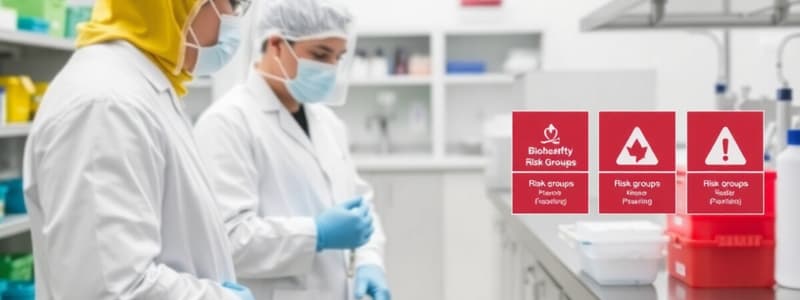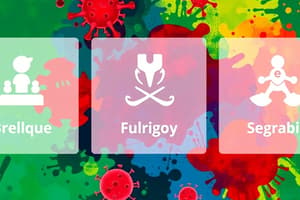Podcast
Questions and Answers
What is the significance of engineering controls in clinical laboratories?
What is the significance of engineering controls in clinical laboratories?
Engineering controls are crucial for minimizing exposure to infectious hazards that cannot be eliminated or substituted.
Explain the difference between Risk Group 2 and Risk Group 3 pathogens.
Explain the difference between Risk Group 2 and Risk Group 3 pathogens.
Risk Group 2 pathogens can cause disease but are unlikely to pose a serious threat to laboratory workers, while Risk Group 3 pathogens typically cause serious diseases but do not usually spread among individuals.
Why is it essential for laboratories to determine the risk group of the organisms they handle?
Why is it essential for laboratories to determine the risk group of the organisms they handle?
Determining the risk group helps evaluate exposure risks and establish appropriate biosafety levels and safety practices.
Describe the biosafety levels and their designations in clinical laboratories.
Describe the biosafety levels and their designations in clinical laboratories.
What type of organisms are typically handled in BSL-3 labs?
What type of organisms are typically handled in BSL-3 labs?
Why are Risk Group 4 pathogens generally not handled in most clinical laboratories?
Why are Risk Group 4 pathogens generally not handled in most clinical laboratories?
What role does ABSA International play in laboratory safety?
What role does ABSA International play in laboratory safety?
How do laboratory design and safety practices relate to biological safety levels?
How do laboratory design and safety practices relate to biological safety levels?
What is the first step in selecting appropriate PPE for a lab?
What is the first step in selecting appropriate PPE for a lab?
List three types of eye protection commonly used in laboratories.
List three types of eye protection commonly used in laboratories.
Why are ordinary prescription glasses inadequate for protection in the lab?
Why are ordinary prescription glasses inadequate for protection in the lab?
When should chemical splash goggles be worn?
When should chemical splash goggles be worn?
In what situations is a face shield required in the lab?
In what situations is a face shield required in the lab?
What must be done if a contact lens becomes contaminated with a hazardous chemical?
What must be done if a contact lens becomes contaminated with a hazardous chemical?
What should be the first step in selecting a lab coat?
What should be the first step in selecting a lab coat?
What are the mandatory minimum PPE requirements in a laboratory?
What are the mandatory minimum PPE requirements in a laboratory?
What should be considered when determining which part of the body to protect in a lab?
What should be considered when determining which part of the body to protect in a lab?
What are the three bloodborne pathogens that healthcare workers should be most concerned about?
What are the three bloodborne pathogens that healthcare workers should be most concerned about?
What does the term 'flame resistant' mean in relation to lab coats?
What does the term 'flame resistant' mean in relation to lab coats?
What types of gloves are typically appropriate for handling most chemicals?
What types of gloves are typically appropriate for handling most chemicals?
Why is it important to use engineering controls instead of relying solely on respirators?
Why is it important to use engineering controls instead of relying solely on respirators?
What is the purpose of the Exposure Control Plan in the OSHA Bloodborne Pathogens Standard?
What is the purpose of the Exposure Control Plan in the OSHA Bloodborne Pathogens Standard?
How do lab coats contribute to safety in laboratory settings?
How do lab coats contribute to safety in laboratory settings?
List two examples of engineering controls that help prevent exposure to bloodborne pathogens.
List two examples of engineering controls that help prevent exposure to bloodborne pathogens.
What should you do if you identify damage to your personal protective equipment (PPE)?
What should you do if you identify damage to your personal protective equipment (PPE)?
What is the purpose of a Safety Data Sheet (SDS)?
What is the purpose of a Safety Data Sheet (SDS)?
What vital equipment must users of respirators comply with according to OSHA?
What vital equipment must users of respirators comply with according to OSHA?
What pathogenic characteristics define a Risk Group 4 pathogen?
What pathogenic characteristics define a Risk Group 4 pathogen?
What action should be taken immediately following an exposure incident involving blood?
What action should be taken immediately following an exposure incident involving blood?
Describe what is meant by 'work practice controls' in the context of handling potentially infectious materials.
Describe what is meant by 'work practice controls' in the context of handling potentially infectious materials.
List two factors that influence the classification of microorganisms by risk group.
List two factors that influence the classification of microorganisms by risk group.
What type of PPE is recommended when working with cryogenic fluids?
What type of PPE is recommended when working with cryogenic fluids?
Which section of the SDS includes First Aid Measures?
Which section of the SDS includes First Aid Measures?
What does BSL-2 typically require in terms of personal protective equipment?
What does BSL-2 typically require in terms of personal protective equipment?
What should be done with needles and other sharps after use to ensure safety?
What should be done with needles and other sharps after use to ensure safety?
What is a key component of a GHS-Compliant Label?
What is a key component of a GHS-Compliant Label?
What factors should be included in a hazard analysis for PPE selection?
What factors should be included in a hazard analysis for PPE selection?
What are bloodborne pathogens primarily known for?
What are bloodborne pathogens primarily known for?
What additional protection may those wearing prescription spectacles need in the lab?
What additional protection may those wearing prescription spectacles need in the lab?
Why are enhanced precautions necessary in a BSL-2 setting?
Why are enhanced precautions necessary in a BSL-2 setting?
Why is it important to treat all blood and body fluids as if they are infectious?
Why is it important to treat all blood and body fluids as if they are infectious?
What should a healthcare worker do if they are unsure how to safely accomplish a task related to exposure risk?
What should a healthcare worker do if they are unsure how to safely accomplish a task related to exposure risk?
Why should face shields be used in combination with safety glasses or goggles?
Why should face shields be used in combination with safety glasses or goggles?
What engineering control measure can be used to minimize exposure to bloodborne pathogens?
What engineering control measure can be used to minimize exposure to bloodborne pathogens?
What role does local immunity play in classifying microorganisms into risk groups?
What role does local immunity play in classifying microorganisms into risk groups?
What is meant by 'infectious aerosols'?
What is meant by 'infectious aerosols'?
How often should PPE be inspected for damage?
How often should PPE be inspected for damage?
What specific actions are prohibited when handling needles to ensure sharps safety?
What specific actions are prohibited when handling needles to ensure sharps safety?
Explain why PPE is considered the 'last line of defense' according to the CDC/NIOSH hierarchy.
Explain why PPE is considered the 'last line of defense' according to the CDC/NIOSH hierarchy.
What action should one take regarding disposable gloves after use?
What action should one take regarding disposable gloves after use?
Which specific pathogens may require BSL-3 practices in a BSL-2 lab?
Which specific pathogens may require BSL-3 practices in a BSL-2 lab?
What determines the appropriate glove material when handling hazardous substances?
What determines the appropriate glove material when handling hazardous substances?
What precautions are typically added in a BSL-2 enhanced setting?
What precautions are typically added in a BSL-2 enhanced setting?
How should PPE be stored to maintain its effectiveness?
How should PPE be stored to maintain its effectiveness?
What is the significance of signal words on chemical labels?
What is the significance of signal words on chemical labels?
Identify one laboratory practice necessary for working with BSL-3 pathogens.
Identify one laboratory practice necessary for working with BSL-3 pathogens.
What does the acronym BSC stand for in the context of laboratory safety?
What does the acronym BSC stand for in the context of laboratory safety?
In relation to biosafety levels, what distinguishes a BSL-4 laboratory from a BSL-3 laboratory?
In relation to biosafety levels, what distinguishes a BSL-4 laboratory from a BSL-3 laboratory?
What kind of environments do basic BSL-1 laboratories typically allow for work?
What kind of environments do basic BSL-1 laboratories typically allow for work?
What types of sanitation measures are included in local preventive strategies against pathogens?
What types of sanitation measures are included in local preventive strategies against pathogens?
Why is it important to consider drug resistance when evaluating local treatment options?
Why is it important to consider drug resistance when evaluating local treatment options?
Study Notes
Risk Groups and Biosafety Levels
-
Pathogens are classified into Risk Groups 1 to 4, with Group 4 being the highest risk.
-
Risk Group 1: unlikely to cause disease in humans or animals.
-
Risk Group 2: can cause disease but unlikely to be a serious hazard to lab workers and the community.
-
Risk Group 3: usually causes serious disease but does not readily spread from person to person.
-
Risk Group 4: usually causes serious disease and can be readily transmitted from person to person.
-
Laboratories are classified into Biosafety Levels (BSL) 1 to 4, with BSL-4 being the highest containment level.
-
Most clinical laboratories operate at BSL-2, handling routine specimens under standard precautions.
-
BSL-3 labs handle higher-risk organisms such as Mycobacterium tuberculosis and Risk Group 3 and 4 pathogens.
-
BSL-4 labs handle the highest risk pathogens.
Personal Protective Equipment (PPE)
- PPE should be the last line of defense against exposures and should be used in conjunction with engineering controls and work practices.
- Mandatory minimum PPE requirements include: protective eyewear, lab coat, closed-toed shoes, and chemical resistant gloves.
- Eye protection is required for several scenarios including working with chemicals, glassware, heating sources, dust, fumes, preserved specimens, and materials that can cause fragmentation or flying particles.
- Eye protection includes safety glasses (with side shields), goggles, and face shields.
- Face shields are used when working with large volumes of hazardous materials or for protection from splashes and flying particles.
- Lab coats provide protection for skin and personal clothing from incidental contact and prevent the spread of contamination.
- Lab coats are available in various materials, including splash resistant, static free, chemical resistant, and flame resistant.
- Gloves should be worn when handling hazardous materials, chemicals of unknown toxicity, corrosive materials, rough or sharp objects, and very hot or cold materials.
- For most circumstances, disposable latex, vinyl, or nitrile examination gloves are sufficient.
- Choose appropriate glove material based on chemical compatibility, degradation rating, breakthrough time, permeation rate, and SDS recommendations.
- Always inspect PPE for damage and contamination prior to use.
- Reusable PPE should be cleaned after each use, while disposable items should only be used once.
Safety Data Sheet (SDS)
- The SDS provides detailed information about a chemical, divided into 16 sections.
- Sections include: product and company identification, hazards identification, composition/information on ingredients, first aid measures, fire-fighting measures, accidental release measures, handling and storage, exposure controls/personal protection, physical and chemical properties, stability and reactivity, toxicological information, ecological information, disposal considerations, transport information, regulatory information, and other information.
- Manufacturer labels should include: product identifier, signal word, hazard statements, precautionary statements, supplier identification, and pictograms.
Bloodborne Pathogens
- Bloodborne pathogens are microorganisms in human blood that can cause disease.
- Examples include hepatitis B (HBV), hepatitis C (HCV), and human immunodeficiency virus (HIV).
- Employers must implement an exposure control plan for the worksite with details on employee protection measures.
- The plan should include engineering and work practice controls, personal protective clothing and equipment, employee training, medical surveillance, hepatitis B vaccinations, and other provisions as required by OSHA.
Bloodborne Pathogens
- Healthcare workers are at risk of exposure to bloodborne pathogens, which are infectious organisms found in human blood and body fluids.
- The most concerning bloodborne pathogens are Hepatitis B virus (HBV), Hepatitis C virus (HCV), and Human immunodeficiency virus (HIV).
- Standard precautions should be used for all blood and body fluids, treating them as potentially infectious.
- Standard precautions apply to blood, body fluids, secretions (except sweat), excretions, non-intact skin, and mucous membranes.
OSHA Bloodborne Pathogens Standard
- The OSHA Bloodborne Pathogens Standard outlines requirements and recommendations for protecting workers from exposure to bloodborne pathogens.
- The standard includes components like an Exposure Control Plan, preventive measures, methods of control, and procedures for exposure incidents.
- Preventive measures include Hepatitis B vaccination and standard precautions.
- Methods of control include engineering and work practice controls, personal protective equipment, proper housekeeping, and labeling.
Engineering Controls
- Engineering controls isolate workers from hazards and minimize exposure to bloodborne pathogens.
- Examples include self-sheathing needles, sharps disposal containers, disposable resuscitation bags, biological safety cabinets, handwashing facilities, and splash shields.
Work Practice Controls
- Work practice controls specify how to perform tasks safely to minimize exposure to bloodborne pathogens.
- Restrictions include no smoking, eating, drinking, applying cosmetics or lip balm, handling contact lenses, and storing food and beverages where blood or other potentially infectious materials (OPIM) are present.
- No mouth pipetting is allowed.
Sharps
- Sharps are objects that can penetrate the skin, including needles, scalpels, and broken glass.
- Proper handling and disposal of sharps are crucial to prevent injury and potential infection.
- Most hospitals use needle/holder combinations with safety devices to cover needles after use.
- Needleless systems are also available for blood collection without needles.
Sharps Safety Procedures
- Place all needles and sharps in puncture-resistant disposal containers immediately after use.
- Use extreme caution or a safety device when removing scalpel blades from their handles.
- Avoid recapping, bending, shearing, or breaking needles. Do not remove needles from holders or syringes.
- Do not fill sharps containers above the maximum fill line (no more than 3/4 full).
Exposure Incident
- An exposure incident occurs when blood or other potentially infectious body fluid comes into contact with mucous membranes or non-intact skin.
- Parenteral exposure is through piercing the skin barrier via needlesticks, cuts, or abrasions.
Exposure Incident Procedures
- If an exposure incident occurs, wash the affected area immediately with soap and water.
- Contact your supervisor immediately, regardless of the time of day.
- Your supervisor will refer you for evaluation and treatment.
- Confidentiality is maintained, and blood testing is only conducted with consent.
Avoiding Exposure
- Safe work practices are essential to prevent infection from bloodborne pathogens.
- Consider how to perform tasks safely to minimize risk.
- Use appropriate engineering controls and personal protective equipment (PPE).
- Ask your supervisor if you are unsure about safe task completion.
Studying That Suits You
Use AI to generate personalized quizzes and flashcards to suit your learning preferences.
Description
Test your knowledge on the classification of pathogens into Risk Groups and the corresponding Biosafety Levels in laboratories. This quiz covers key details about each level's risks and required precautions for handling infectious agents. Understand the importance of Personal Protective Equipment (PPE) in ensuring safety in lab environments.




